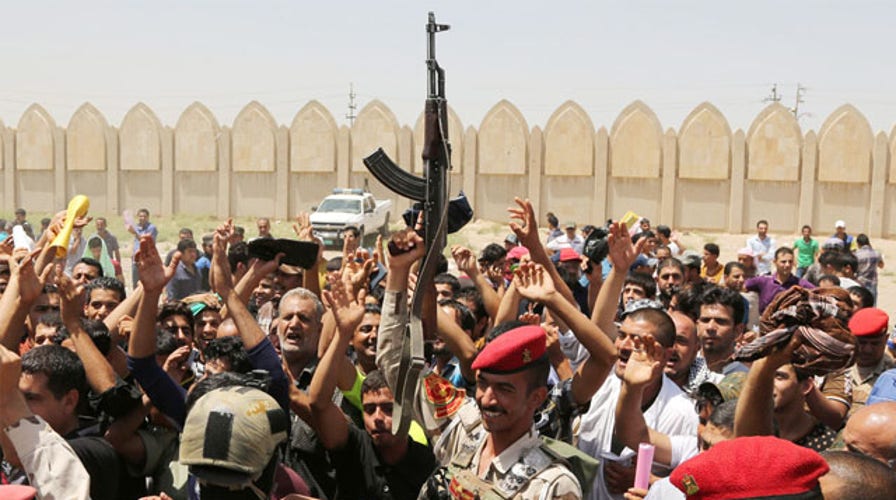275 special forces troops sent to Iraq to protect US assets
Is this the start of a boots-on-the-ground strategy?
President Obama huddled with top congressional leaders on Wednesday to discuss ramping up U.S. involvement in the Iraq crisis, and is said to be leaning toward sending U.S. special forces into the country.
White House officials stress that several options remain on the table and no decision has been made. But the president reportedly has, for now, ruled out using airstrikes against the Al Qaeda-inspired Sunni Muslim insurgency that has seized vast swaths of territory in the north and west of Iraq.
According to The Wall Street Journal, the concern is that U.S. commanders lack sufficient intelligence to determine clear battlefield targets.
A senior official told Fox News that the president instead appears to be leaning toward sending roughly 100 special forces into the region. Such a contingent presumably would be sent to help train the Iraqi military and boost intelligence available to the Iraqis.
The president likely was using his meeting with top congressional leaders Wednesday afternoon to take their pulse on these options, recognizing that his Democratic colleagues may be a tougher sell. House Democratic Leader Nancy Pelosi, among those attending the Oval Office meeting, has voiced concern about any U.S. involvement in the sectarian crisis in Iraq.
House Speaker John Boehner, Senate Democratic Leader Harry Reid, and Senate Republican Leader Mitch McConnell also attended.
More broadly, the Obama administration is pressing for Iraqi Prime Minister Nouri al-Maliki to take steps to make his Shiite-dominated government more inclusive. Obama said last week that any short-term U.S. military actions in Iraq would not be successful unless they were accompanied by political changes by the government in Baghdad.
The efforts of U.S. intelligence have been hindered by the withdrawal of American forces from Iraq in 2011 and the ongoing Syrian civil war, which has left large parts of both countries off-limits to operatives.
The Associated Press reported Wednesday that U.S. intelligence analysts are working to track the movements of key figures in the Islamic State of Iraq and Syria, which seized Mosul, Tikrit and other towns in Iraq last week as the country's military melted away. They are sifting through data provided by Jordanian, Saudi, Turkish and other intelligence services, as well as their own human sources, satellites, drones and communications intercepts by the National Security Agency, U.S. intelligence officials say. The officials would not be quoted by name because they were not authorized to discuss the classified details publicly.
It's unclear whether the CIA and the NSA have been able to locate the top insurgent figures, such as Abu Bakr al-Baghdadi, the ISIS's leader. Baghdadi, who was released in 2009 after spending four years in U.S. military custody in southern Iraq, came away with an appreciation of American monitoring technology that made him an elusive target once he took command, said Richard Zahner, a retired Army general and former senior NSA official.
One hurdle is that much of the intelligence network the U.S. built up during eight years of fighting in Iraq has been dismantled, including a network of CIA and Pentagon sources and an NSA system that made available the details of every Iraqi insurgent email, text message and phone-location signals in real time, said John "Chris" Inglis, who recently retired as the NSA's top civilian. Some monitoring is still possible, Zahner said.
The CIA and other agencies are assembling detailed dossiers known as "targeting packages" that amount to profiles of insurgent commanders, including as much day-to-day information as can be gathered about their location, movements, associates and communications. Those packages can be used to target the subjects for drone strikes or other military action, though they also can be used for nonlethal purposes, current and former officials say.
More than a year ago, the CIA's Counterterrorism Center expanded a team of officers at the agency's headquarters in northern Virginia to track and target Al Qaeda-linked militants operating in Syria and Iraq. Those efforts are now intensifying, U.S. officials say.
Despite challenges, intelligence agencies know "quite a bit" about the current organization and its leadership, said a senior U.S. intelligence official, expressing a widely held view within the CIA and other agencies.
The spy agencies appear to have been surprised by the sudden move by ISIS to seize Mosul and other cities.
Still, there was some warning. One top official, Lt. Gen Mike Flynn of the Defense Intelligence Agency, predicted to Congress in February that the ISIS "probably will attempt to take territory in Iraq and Syria to exhibit its strength in 2014, as demonstrated recently in Ramadi and Fallujah, and the group's ability to concurrently maintain multiple safe havens in Syria."
Behind the scenes, intelligence analysts warned about the increasing difficulties Iraq's security forces faced in combating ISIS, and the political strains that were contributing to Iraq's declining stability, a senior intelligence official said. They reported on ISIS's efforts to spark uprisings in areas with substantial Sunni populations and how the Iraqi military's failure to counter ISIS gains in Mosul allowed the group to deepen its influence there.
Fox News' Ed Henry and The Associated Press contributed to this report.





